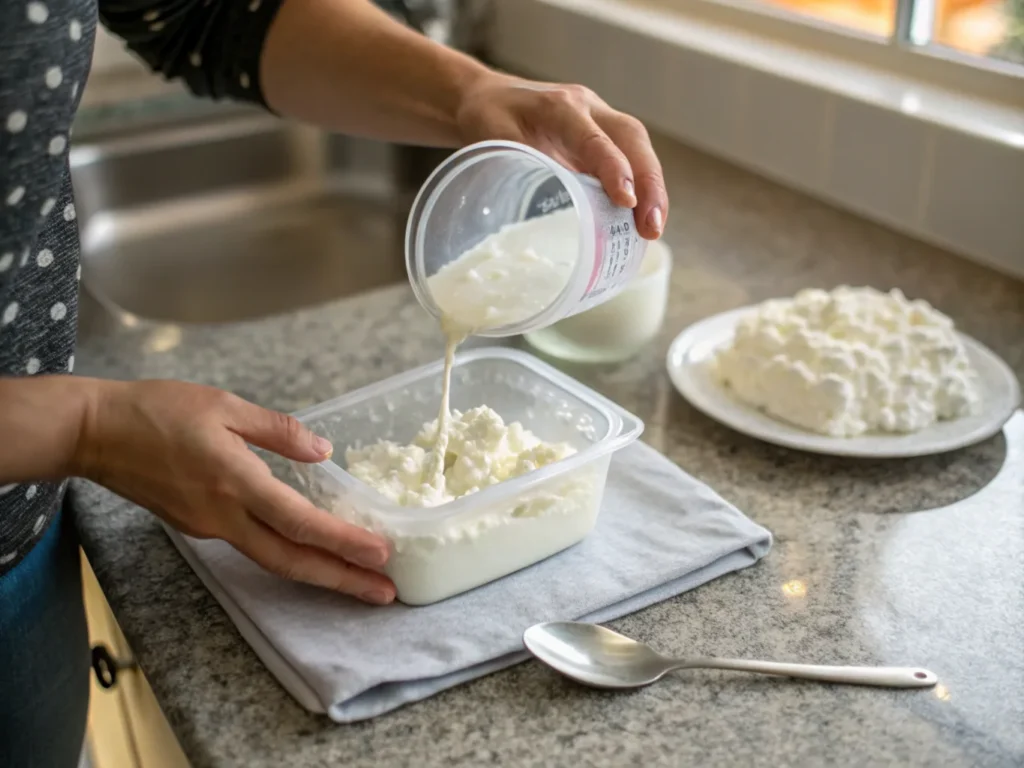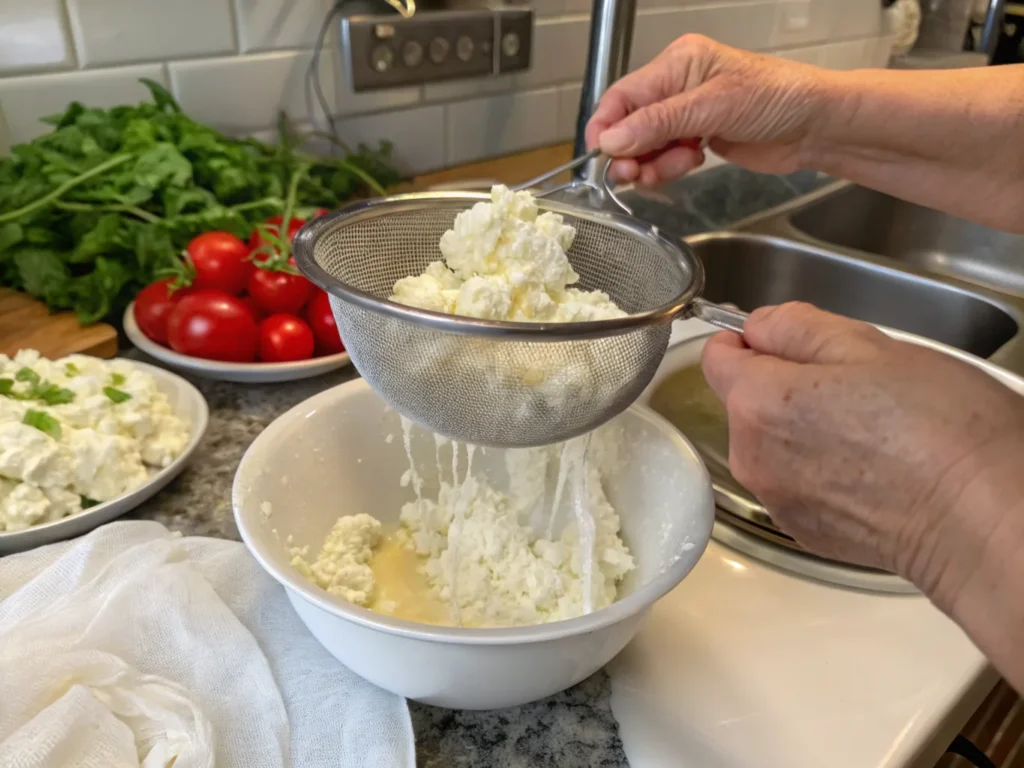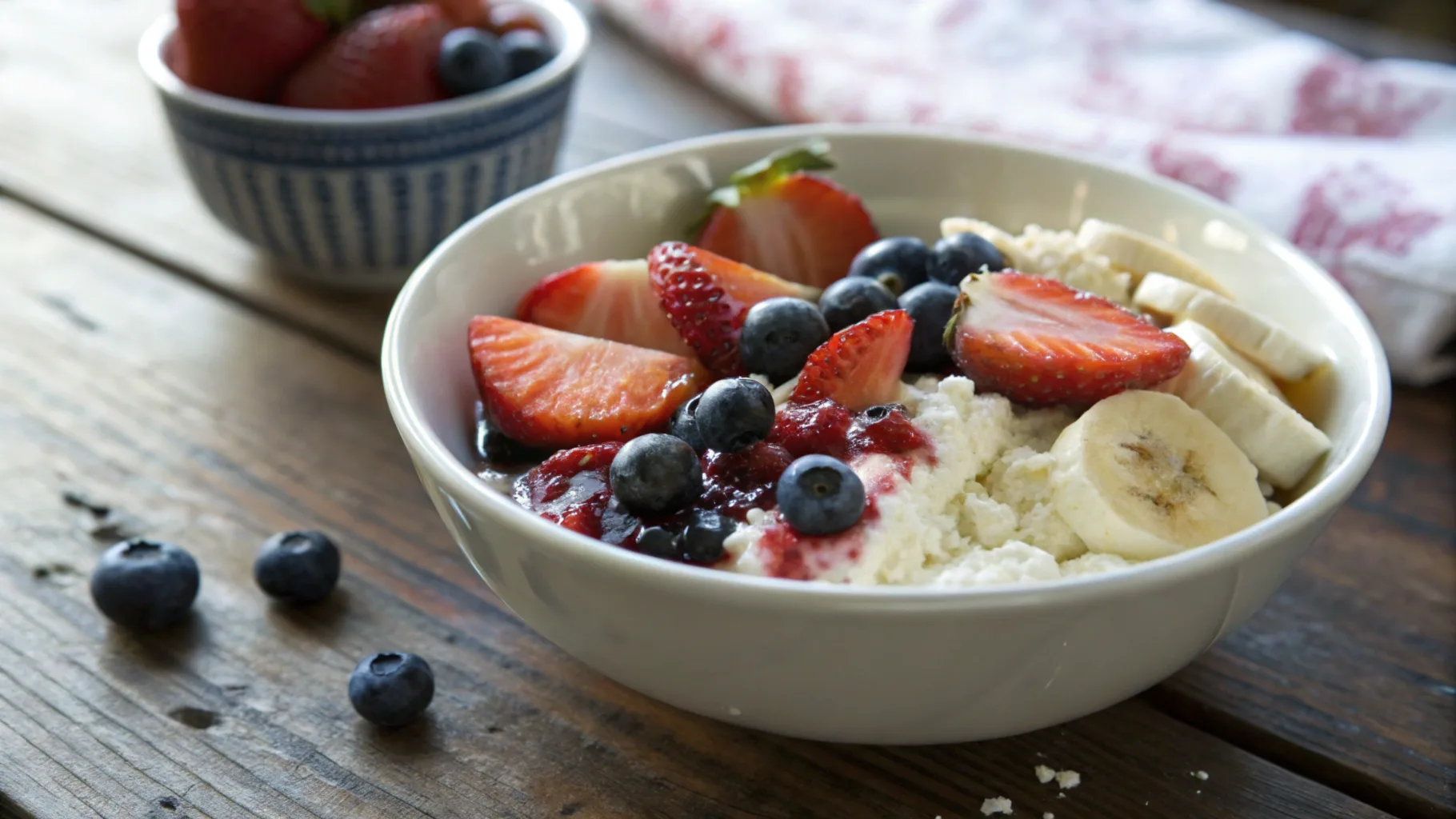Introduction
Cottage cheese is a popular dairy product known for its creamy texture and high-protein content. However, it often raises concerns due to the watery consistency that can form on top. Is watery cottage cheese ok to eat? This is a common question among those who enjoy this nutritious food but are unsure about its safety or taste when it becomes watery. In this article, we will explore the reasons behind the watery texture, its safety, and ways to fix or even embrace it. We’ll also discuss some creative ways to use watery cottage cheese in your recipes.
Table of contents
Understanding Cottage Cheese Consistency
Cottage cheese comes in various textures, ranging from smooth and creamy to slightly lumpy, but one thing is for certain – it can become watery. This liquid that appears on top is actually whey, the liquid portion of milk that separates from the curds during the cheese-making process. The consistency of cottage cheese largely depends on the curd size and water content, which can vary from brand to brand and batch to batch. While some people enjoy the creamier, thicker cottage cheese, others may encounter a watery version that may affect the taste and texture.
In addition, the presence of liquid does not necessarily mean that the cottage cheese is spoiled. Still, it’s essential to understand what causes the water to separate in order to determine whether it’s okay to consume.
If you’re curious about why your cottage cheese might seem watery, check out this guide on moist cottage cheese, which explains the reasons behind the separation and what you can do to manage it.
Is Watery Cottage Cheese Safe to Eat?
When faced with watery cottage cheese, the question arises: Is moist cottage cheese ok to eat? The short answer is yes, but with a few important considerations. Typically, moist cottage cheese is safe to consume, as long as it has been properly stored and has not exceeded its expiration date. However, there are certain factors to keep in mind before indulging in moist cottage cheese.

Potential for Spoilage
One of the main concerns with moist cottage cheese is the possibility of spoilage. If the cheese has been sitting in your fridge for an extended period or has been improperly stored, the liquid could indicate the growth of bacteria or mold. Therefore, it’s crucial to always check for signs of spoilage before consuming it. If the cottage cheese smells sour, has an off texture, or shows visible signs of mold, it’s best to discard it.
For advice on how cottage cheese behaves in various recipes, like flatbreads, you can refer to this article on soggy flatbreads.
Differences between Watery and Regular Cottage Cheese
The primary difference between moist cottage cheese and regular cottage cheese lies in the water content. Regular cottage cheese typically has less liquid, giving it a thicker and creamier texture. In contrast, moist cottage cheese has a higher moisture content, making it more liquid and runny. The main cause of this difference is the curd formation process during cheese-making, where the curds may either hold more moisture or release excess liquid. This can vary depending on the production method, storage, and time since opening the container.
While both types of cottage cheese are made from the same basic ingredients, their texture and consistency can significantly impact the taste and usability. The presence of extra liquid might make watery cottage cheese less suitable for certain dishes that require a thicker texture.
Why Does Cottage Cheese Become Watery?
Several factors contribute to cottage cheese becoming watery. Is moist cottage cheese ok to eat? Yes, but understanding why this happens can help you manage the texture better and prevent it in the future.
Storage and Handling Issues
Improper storage is one of the main culprits behind watery cottage cheese. For example, if the cheese has been exposed to air or stored improperly in a container that doesn’t seal well, the liquid can separate more quickly. Moreover, fluctuating temperatures in the refrigerator can cause the curds to lose moisture. Therefore, it’s essential to store cottage cheese in a sealed container and keep it consistently refrigerated.
Milk Fat Content and Water Separation
Another reason for moist cottage cheese is the fat content of the milk used during the production process. Low-fat or fat-free cottage cheese often has a thinner consistency because it retains more moisture. On the other hand, full-fat cottage cheese tends to have a creamier texture because the higher fat content helps prevent excessive water separation. If you find that your cottage cheese is watery, it might be due to the specific type of milk or the fat content.
Is It Healthy to Consume Watery Cottage Cheese?
Cottage cheese is already known for its health benefits, such as being high in protein and low in fat, making it a nutritious choice. But does the watery version affect its healthiness? Is moist cottage cheese ok to eat from a nutritional standpoint? The answer is yes, as long as the cheese has been stored properly and hasn’t spoiled. The watery liquid is typically just whey, which contains proteins, vitamins, and minerals.
If you’re interested in how watery cottage cheese works in baking, read this article on what cottage cheese does in baking.
Impact on Digestion
Some people find that consuming watery curds is easier to digest due to its higher moisture content. The increased liquid in the cheese may help break down the proteins more efficiently, making it gentler on the stomach. However, if you’re lactose intolerant or have a sensitivity to dairy, the liquid whey may still cause discomfort. As a result, it’s important to pay attention to how your body reacts after consuming moist cottage cheese.
Ways to Fix Watery Cottage Cheese
If you prefer thicker cottage cheese but are faced with a watery version, there are ways to fix it. Fortunately, fixing watery curds is a straightforward process.
Straining the Excess Water
One effective way to remove excess water from cottage cheese is by using a strainer or cheesecloth. Simply place the cottage cheese in the strainer over a bowl, allowing the liquid to drain off. You can also gently press the curds to speed up the process. This method works best when you want to retain the creamy texture without the added liquid.
Mixing and Stirring Techniques
If you don’t want to strain your cottage cheese, mixing and stirring it thoroughly can help distribute the water more evenly throughout the curds. This technique can prevent the liquid from collecting on the surface, making it more enjoyable to eat. Stirring also helps incorporate the whey into the curds, giving the cottage cheese a creamier consistency.

Alternatives to Watery Cottage Cheese
If you prefer a thicker consistency or simply want to avoid watery cottage cheese, there are some excellent alternatives available.
Different Brands and Their Textures
Many brands offer cottage cheese with different textures, so choosing the right one can make a difference. Some brands make thicker, creamier versions, while others have a more liquid consistency. If you find that one brand produces watery cottage cheese more often than others, consider switching to a different brand. You can even experiment with small-batch or artisan cottage cheese varieties that may have a more consistent texture.
Recipes Using Watery Cottage Cheese
Even if you find yourself with watery cottage cheese, don’t discard it just yet. There are several creative ways to use it in your cooking. Is watery cottage cheese ok to eat in recipes? Absolutely. Here are some ideas to try:
Creative Cottage Cheese Recipes
- Smoothies: Use watery cottage cheese as a base for a high-protein smoothie. Blend it with fruits like berries, bananas, or mangoes for a creamy consistency.
- Pancakes: Add cottage cheese to pancake batter for extra moisture and protein. The watery version will still work well, giving the pancakes a light and fluffy texture.
- Salads: Incorporate watery cottage cheese into salads, where its texture won’t be as noticeable. You can even use it as a topping for grilled vegetables or green salads for a healthy twist.
Discover why baking cottage cheese is trending and how this technique can transform its texture.

FAQs
Why is my cottage cheese watery?
Cottage cheese becomes watery due to the separation of whey, which can occur due to several factors, such as storage issues, temperature fluctuations, or the fat content of the milk used. Low-fat or fat-free cottage cheeses are more likely to be watery because they retain more moisture. Additionally, improper sealing or exposure to air can cause more liquid to separate over time.
Why is there liquid in cottage cheese?
The liquid in cottage cheese is whey, which naturally separates from the curds during the cheese-making process. The amount of liquid can vary depending on factors such as the fat content of the milk, curd size, and storage conditions. Higher moisture content can result in more liquid, and some brands may produce cottage cheese with more whey than others.
Is it OK to eat wet cheese?
Wet cheese, or cheese with excess liquid, like watery curds, is usually safe to eat if it has been stored properly and has not exceeded its expiration date. The liquid is typically whey, a natural part of the cheese-making process. However, if the cheese has a sour smell, strange texture, or visible mold, it’s best to avoid consumption as it may indicate spoilage.
What happens if I ate bad cottage cheese?
Eating bad cottage cheese can lead to food poisoning. If the cheese has gone bad, it may cause symptoms like nausea, vomiting, stomach cramps, and diarrhea. This occurs because of the growth of harmful bacteria such as Salmonella or Listeria. If the cottage cheese smells sour, has an off texture, or shows signs of mold, it’s essential to discard it immediately to avoid any health risks.
Conclusion
In conclusion, watery curds is not only safe to eat but can also be versatile in various recipes. While it may not be the preferred texture for everyone, understanding why it becomes watery and how to fix it can help you enjoy this nutritious food without waste. Whether you choose to strain it, stir it, or find creative ways to incorporate it into meals, watery cottage cheese remains a healthy and delicious option. Is watery cottage cheese ok to eat? Yes, and with the right techniques, you can make the most of it.

